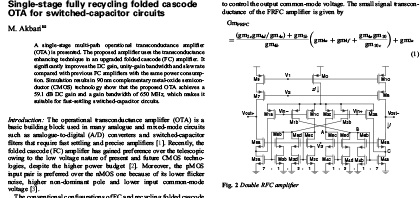The operational transconductance amplifier (OTA) is a basic building block used in many analogue and mixed-mode circuits such as analogue-to-digital (A D) converters and switched-capacitor filters that require fast settling and precise amplifiers [1]. Recently. the folded cascode (FC) amplifier has gained preference over the telescopic owing to the low voltage nature of present and future CMOS technologies. despite the higher power budget [2]. Moreover. the pMOS input pair is preferred over the nMOS one because of its lower flicker noise. higher non-dominant pole and lower input common-mode voltage [3]. The conventional configurations of FC and recycling folded cascode (RFC) amplifiers are shown in Figs. 1a and b. Transistors M3 and M4 of the FC draw the most current and have the largest transconductance. Therefore the RFC amplifier utilises M3 and M4 as driving transistors and the input drivers M1 and M2 in Fig. 1a are divided into M1a-M2a and M1b-M2b as in Fig. 1b. which now conduct a current flow equal to I 2 [2]. These modifications lead to better transconductance and slew rate. However. to improve the power efficiency of the RFC amplifier. the double-RFC (DRFC) amplifier (shown in Fig. 2) has been presented in [4]. In this circuit. the differential input pair is now replaced by a triplet (M1a-M2a. M1b-M2b and M1c-M2c) and the current mirrors (M3c-M6c and M3d-M6d) are added as the double recycling structure to increase transconductance. Other techniques to enhance the performance of FC and RFC amplifiers such as the improved recycling structure [5] and multipath schemes [3. 6] can be also utilised.

 Iran Energy News Oil, Gas, Petrochemical and Energy Field Specialized Channel
Iran Energy News Oil, Gas, Petrochemical and Energy Field Specialized Channel



